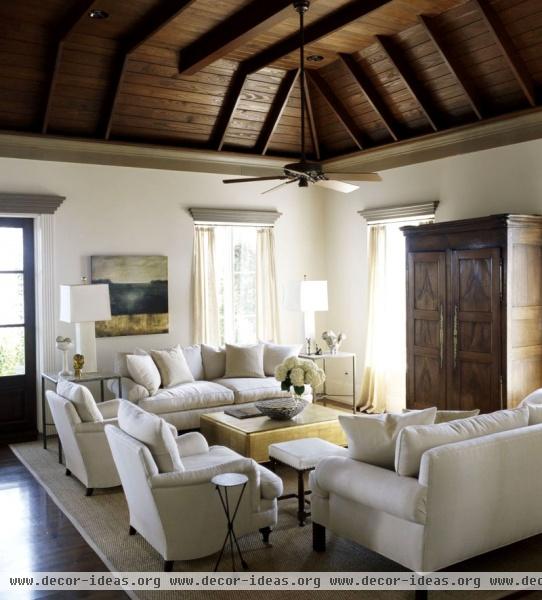THE WHITE STUFF(2)

THE WHITE STUFF
Faced with a steep and narrow lot, Leah ingeniously resculpted the land into terraces "so I could have different levels and outdoor spaces." She also obtained planning permission to build the house closer to the street to avoid encroaching on the roots of a massive live oak tree the family calls Grace. At the top of the hill stands the two-story house; at the bottom is a pier and a guest cottage, and in between, knit together by wood staircases, are areas that accommodate everything from solitary soul-searching- "Whenever I have a brain cramp, I have to go outside and clear my head," the designer says with a laugh- to "antipasto lunches with girlfriends," galas for Habitat for Humanity, and get-togethers for the young Estonian Lutheran missionaries whom the couple sponsor in the United States.
Life at the Richardsons' has an open-arms generosity to it, so the loft-like main floor, with its broad windows and covered flagstone terrace, is "just one big welcoming room," Leah says. "I've always liked large rooms, and it's easy to develop smaller, intimate spaces within that larger space."
The kitchen and areas for living and dining are gathered beneath a vaulted wood ceiling with exposed beams, and sturdy fluted columns inspired by traditional Mediterranean architecture help define the multipurpose space. So does the single long step that separates the travertine-paved entrance area from the burnished wood floor of the main room; the walnut-stained heart pine planks were milled from the beams of an old Tennessee barn. Additional salvaged bits have been incorporated into the structure. The Italianate front door came from a historic mansion in Pensacola, for instance, and the louvered wall in the study is made of exterior shutters from her father and grandfather's law office. The delicately leaded windows set above the kitchen cabinets once graced a 19th-century Alabama church. "My mother thought I needed to make the kitchen more personal, and since I liked the idea of letting in some light up high on the wall, I took her suggestion."
That moment of solidarity aside, however, the tastes of mother and daughter diverge dramatically. "You know the adage about the apple not falling far from the tree?" Leah asks. "Well, I'm in a whole different orchard. My mother is an artist, and she loves color. She loves pattern. She loves lots and lots of stuff." Leah, on the other hand, edits accessories to the minimum ("stuff encumbers your life"), and most of the upholstery is milk-white linen and cotton. ("People are so afraid of white, but you can always bleach it.") In fact, except for some brilliantly flowered cushions in her daughter's bedroom, the only color in the house that isn't white, the browns of natural wood and rattan, or the sandy beige of woven sisal is a shade of sage green so pale and elusive that it barely registers to the unsuspecting eye.
Neutrals don't mean better-safe-than-sorry decorating. "I love the mix of heavy-weave linen with tighter-weave linen, the quilting of matelassé, the nubbiness of cotton." And Leah's roving eye has led her to accumulate a carefully edited collection of objects whose power is in their scale and silhouette. A grand wood armoire anchors one end of the living area, while strong, square armchairs by her hero, designer John Saladino, are pulled up to the long limestone-topped dining table. In the entrance area stands a low, lean daybed by the 20th-century modernist Mies van der Rohe; most people upholster it in black leather, but Leah dressed it in white, a startlingly fresh choice that takes decades off the 1929 design icon. It's a thoughtful departure from the norm that exemplifies Leah's design approach.
"My philosophy can be found in Proverbs," Leah says. "By wisdom a house is built, and through understanding, it is established; through knowledge its rooms are filled with rare and beautiful treasures." And don't forget machine-washable slipcovers, too.
URL: THE WHITE STUFF(2) http://decor-ideas.org/cases-view-id-1237_2.html











